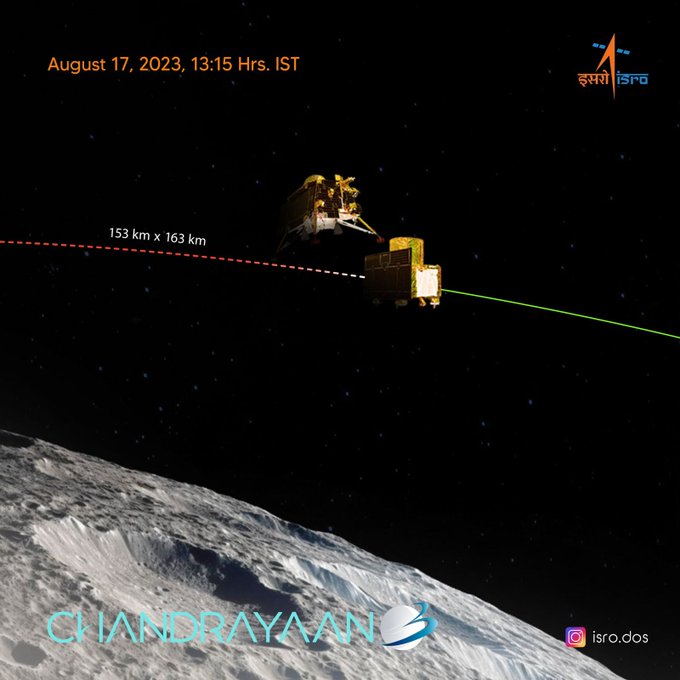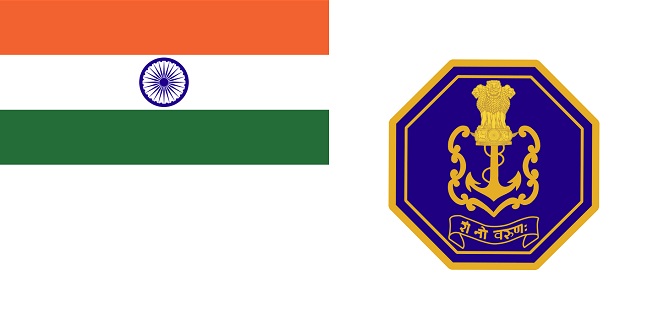
Chandrayaan-3 successfully conducts separation of Lander Module from Propulsion Module. Photo: ISRO.
BENGALURU (PTI): India's Chandrayaan-3 mission on Thursday achieved a major milestone when its Lander Module carrying the rover inside successfully separated from the Propulsion Module to be on course for an unprecedented soft-landing on the moon's south pole planned on August 23.
The Lander Module comprising the lander Vikram and rover Pragyan is now ready to be lowered to an orbit that takes it closer to the moon's surface. The soft landing on the lunar south pole is scheduled at 5.47 pm next Wednesday.
"Thanks for the ride, mate! said the Lander Module (LM). LM is successfully separated from the Propulsion Module (PM). LM is set to descend to a slightly lower orbit upon a deboosting planned for tomorrow around 1600 Hrs IST," the Indian Space Research Organisation (ISRO) said in a post on X (formerly Twitter). The estimated
Rs 600 crore Chandrayaan-3 mission was launched on July 14, a far more complicated 41-day voyage to reach the lunar south pole.
After Thursday's separation, the lander is expected to undergo a "deboost" (the process of slowing down) to place it in an orbit, where the Perilune (the orbit's closest point to the Moon) is 30 km and Apolune (farthest point from the Moon) is 100 km, from where the soft landing on the south polar region of the Moon will be attempted, an ISRO official said.
The Propulsion Module will continue its journey in the current orbit for months/years, the ISRO said.
"Now really the match starts. These are the final overs we are talking about," Chandrayaan-I Project Director M Annadurai told PTI.
Chandrayaan-3 is a follow-on mission to Chandrayaan-2 and its objectives are to demonstrate safe and soft landing on the lunar surface, roving on the moon, and to conduct in-situ scientific experiments.
Chandrayaan-2 had failed in its lunar phase when its lander 'Vikram' crashed into the surface of the moon following anomalies in the braking system in the lander while attempting a soft landing on September 7, 2019. Chandrayaan's maiden mission was in 2008.
The lander has the capability to soft land at a specified lunar site and deploy the rover that will carry out in-situ chemical analysis of the moon's surface during the course of its mobility.
The lander and the rover have scientific payloads to carry out experiments on the lunar surface.
If the Chandrayaan-3 mission succeeds in landing a robotic lunar rover in ISRO's second attempt in four years, India will become the fourth country to master the technology of soft-landing on the moon's surface after the US, China and the former Soviet Union.
The race to the uncharted south pole of the Moon is also hotting up with Russia's Luna-25 also gearing up for lunar landings next week. The proximity, possible overlap, of their landing dates -- August 21-23 for Luna-25 and August 23-24 for Chandrayaan-3 -- has heightened excitement in the scientific community worldwide.
Polar regions of the moon are a very different terrain due to the environment and the difficulties they present and therefore have remained unexplored. All the previous spacecraft to have reached the moon landed in the equatorial region, a few degrees latitude north or south of the lunar equator.
The moon's south pole region is also being explored because there could be a possibility of presence of water in permanently shadowed areas around it.
"It(separation) is a great moment and this will imply how the lander is performing and the lander will be verified and tested and brought closer and closer to the moon. Then it will be given the required commands such that it takes over on the cue on August 23 to go all the way to the targeted place and have a safe and secure landing," Annadurai said.
He said this is the beginning and all further milestones have to be seen very carefully.
"We have crossed major milestones from the launch vehicle and after that the propulsion system (separation)...now really the match starts. These are the final overs we are talking about. I think it is a great moment. The whole world is waiting to see what Vikram will do and what Pragyan will come out and do... I am also enthusiastically waiting."
ISRO Chairman S Somanath had recently said the most critical part of the landing is the process of bringing the velocity of the lander from 30 km height to the final landing, and that the ability to transfer the spacecraft from horizontal to vertical direction is the "trick we have to play" here.
"The velocity at the starting of the landing process is almost 1.68 km per second, but this speed is horizontal to the surface of the moon. The Chandrayaan-3 here is tilted almost 90 degrees, it has to become vertical. So, this whole process of turning from horizontal to vertical is a very interesting calculation mathematically. We have done a lot of simulations. It is here where we had the problem last time (Chandrayaan-2)," Somanath explained.
The significance about Chandrayaan-3 mission, unlike its unsuccessful predecessor, is that the PM has a payload -- SHAPE -- Spectro- polarimetry of HAbitable Planet Earth which is to study earth from lunar orbit.
The ISRO said the SHAPE is an experimental payload to study the spectro-polarimetric signatures of the Earth in the near-infrared wavelength range.
Apart from the SHAPE payload, the PM's main function is to carry the LM from launch vehicle injection orbit till lander separation.
The lander module after landing on the surface of the moon has payloads including RAMBHA-LP which is to measure the near surface plasma ions and electrons density and its changes, ChaSTE Chandra's Surface Thermo Physical Experiment -- to carry out the measurements of thermal properties of lunar surface near polar region-- and ILSA (Instrument for Lunar Seismic Activity) to measure seismicity around the landing site and delineating the structure of the lunar crust and mantle.
The rover, after the soft-landing, would come out of the lander module and study the surface of the moon through its payloads APXS - Alpha Particle X-Ray Spectrometer - to derive the chemical composition and infer mineralogical composition to further enhance understanding of the lunar surface.
The rover, which has a mission life of 1 lunar day (14 Earth days), also has another payload Laser Induced Breakdown Spectroscope (LIBS) to determine the elemental composition of lunar soil and rocks around the lunar landing site.
 Previous Article
Previous Article Next Article
Next Article













The Indian Air Force, in its flight trials evaluation report submitted before the Defence Ministry l..
view articleAn insight into the Medium Multi-Role Combat Aircraft competition...
view articleSky enthusiasts can now spot the International Space Station (ISS) commanded by Indian-American astr..
view article